Inclusive Sport Funding: A Case for Supporting All, Not Just the Elite
VerifiedAdded on 2023/06/08
|6
|1297
|270
Essay
AI Summary
This essay argues that sports funding should be allocated to all sports, not just elite ones, to foster growth, create opportunities, and promote balanced development. It highlights the importance of equitable funding for broader sports like surfing, referencing Australia's shift towards a more balanced sports policy. The essay emphasizes that investing in mass sports increases participation, promotes sportsmanship, and reduces issues like corruption and doping. It suggests promoting sports that attract public interest to encourage stakeholder investment. While acknowledging the importance of elite sports, the essay advocates for grassroots investment to improve overall participation and address inequalities between private and state-run schools, ultimately paving the way for broader sports development and individual recreation. Desklib provides access to this essay and many other resources for students.
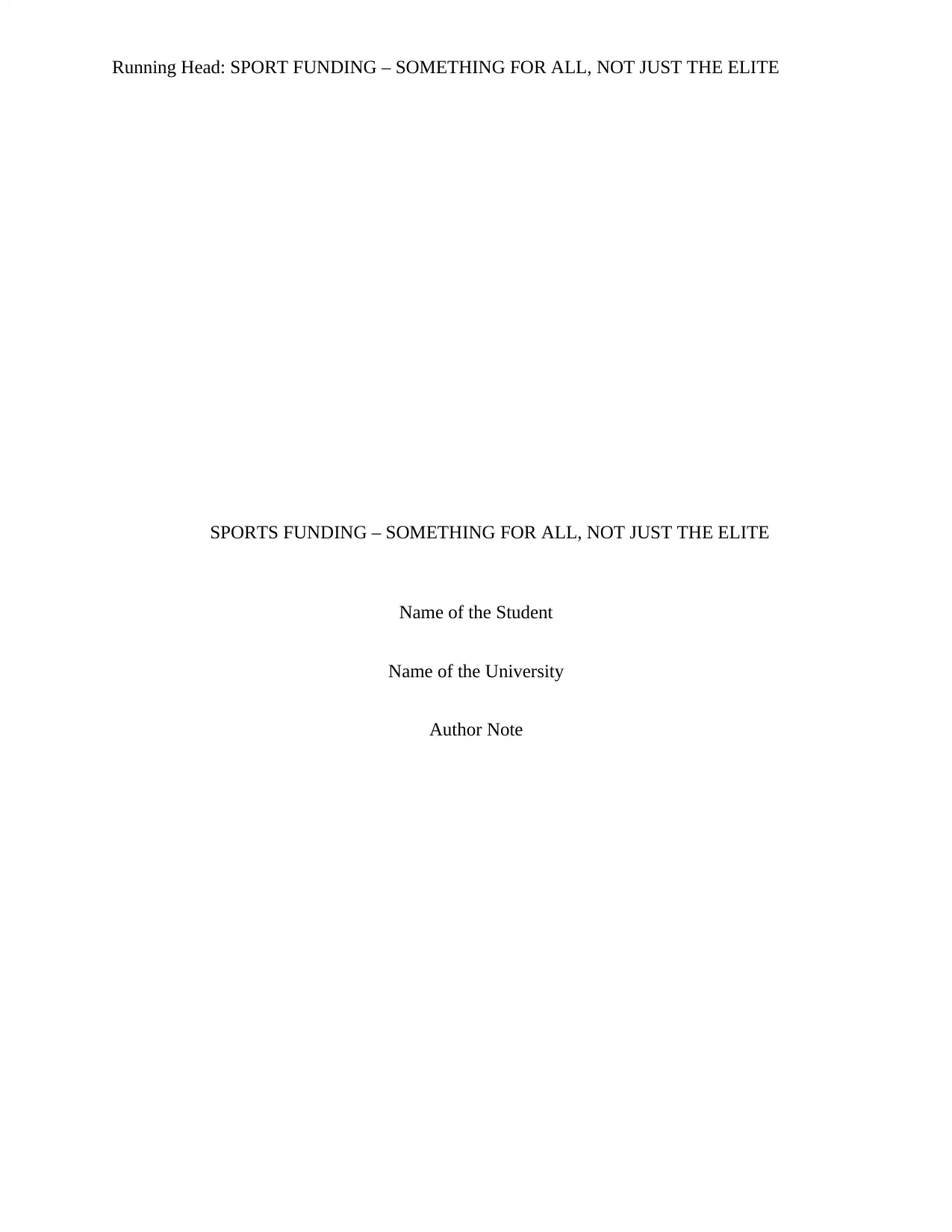
Running Head: SPORT FUNDING – SOMETHING FOR ALL, NOT JUST THE ELITE
SPORTS FUNDING – SOMETHING FOR ALL, NOT JUST THE ELITE
Name of the Student
Name of the University
Author Note
SPORTS FUNDING – SOMETHING FOR ALL, NOT JUST THE ELITE
Name of the Student
Name of the University
Author Note
Paraphrase This Document
Need a fresh take? Get an instant paraphrase of this document with our AI Paraphraser
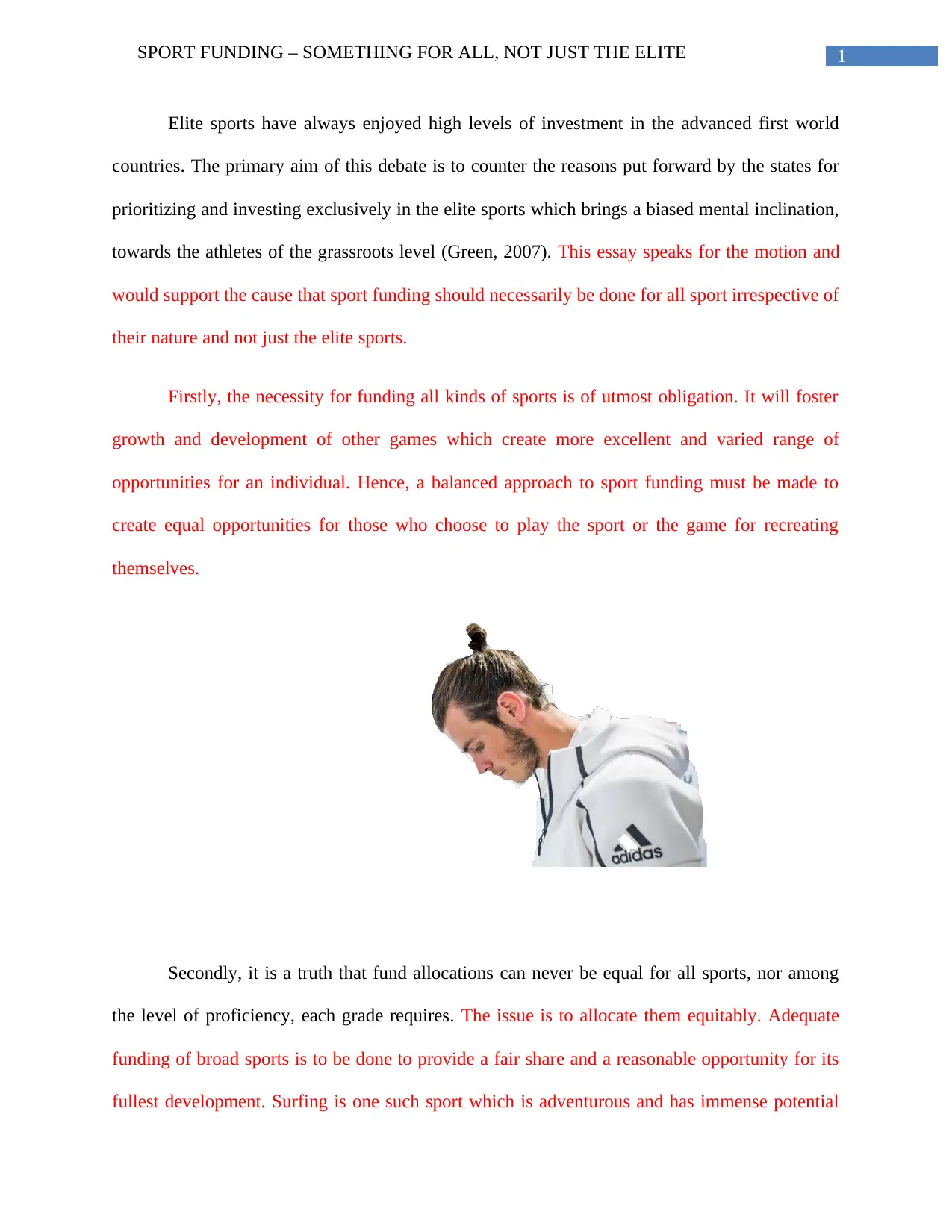
1SPORT FUNDING – SOMETHING FOR ALL, NOT JUST THE ELITE
Elite sports have always enjoyed high levels of investment in the advanced first world
countries. The primary aim of this debate is to counter the reasons put forward by the states for
prioritizing and investing exclusively in the elite sports which brings a biased mental inclination,
towards the athletes of the grassroots level (Green, 2007). This essay speaks for the motion and
would support the cause that sport funding should necessarily be done for all sport irrespective of
their nature and not just the elite sports.
Firstly, the necessity for funding all kinds of sports is of utmost obligation. It will foster
growth and development of other games which create more excellent and varied range of
opportunities for an individual. Hence, a balanced approach to sport funding must be made to
create equal opportunities for those who choose to play the sport or the game for recreating
themselves.
Secondly, it is a truth that fund allocations can never be equal for all sports, nor among
the level of proficiency, each grade requires. The issue is to allocate them equitably. Adequate
funding of broad sports is to be done to provide a fair share and a reasonable opportunity for its
fullest development. Surfing is one such sport which is adventurous and has immense potential
Elite sports have always enjoyed high levels of investment in the advanced first world
countries. The primary aim of this debate is to counter the reasons put forward by the states for
prioritizing and investing exclusively in the elite sports which brings a biased mental inclination,
towards the athletes of the grassroots level (Green, 2007). This essay speaks for the motion and
would support the cause that sport funding should necessarily be done for all sport irrespective of
their nature and not just the elite sports.
Firstly, the necessity for funding all kinds of sports is of utmost obligation. It will foster
growth and development of other games which create more excellent and varied range of
opportunities for an individual. Hence, a balanced approach to sport funding must be made to
create equal opportunities for those who choose to play the sport or the game for recreating
themselves.
Secondly, it is a truth that fund allocations can never be equal for all sports, nor among
the level of proficiency, each grade requires. The issue is to allocate them equitably. Adequate
funding of broad sports is to be done to provide a fair share and a reasonable opportunity for its
fullest development. Surfing is one such sport which is adventurous and has immense potential
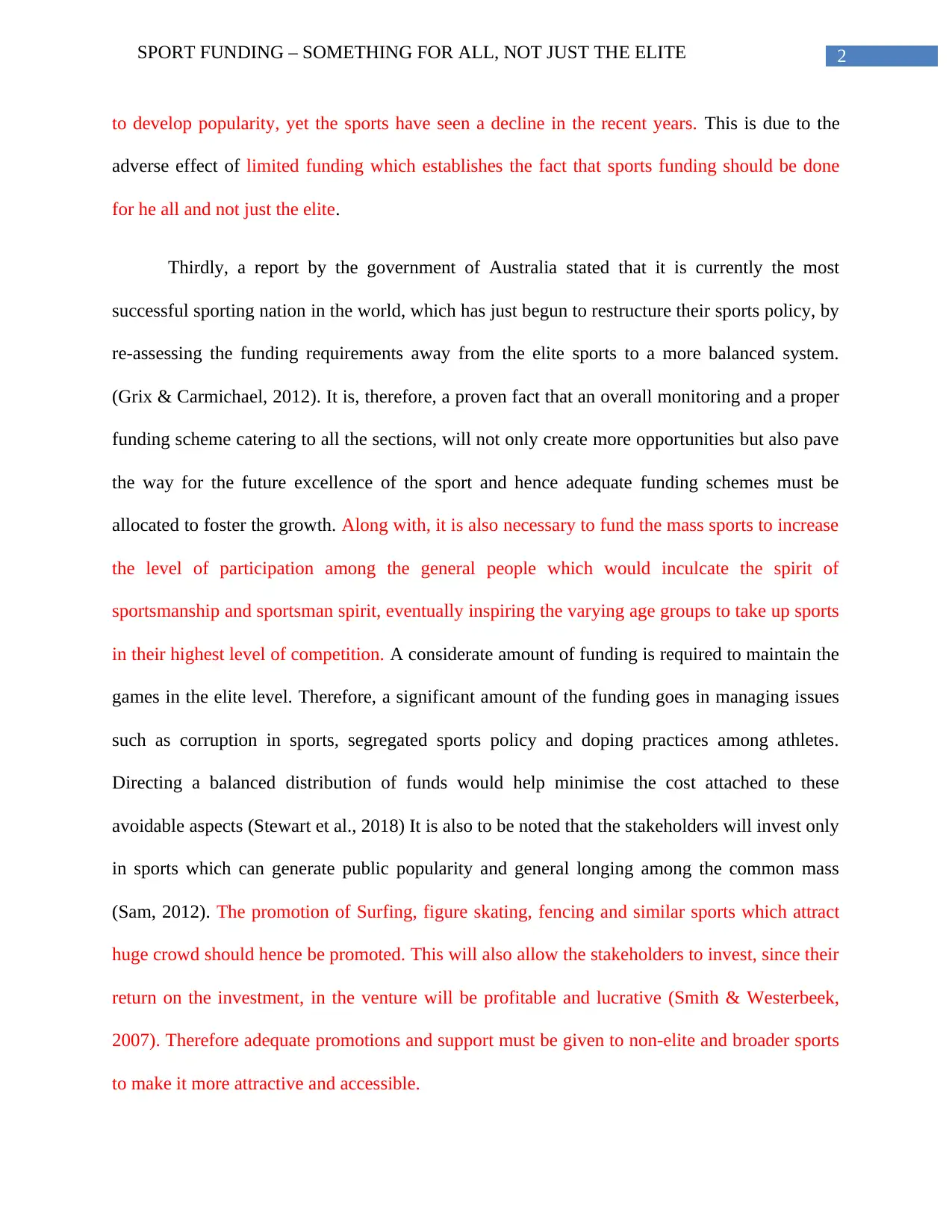
2SPORT FUNDING – SOMETHING FOR ALL, NOT JUST THE ELITE
to develop popularity, yet the sports have seen a decline in the recent years. This is due to the
adverse effect of limited funding which establishes the fact that sports funding should be done
for he all and not just the elite.
Thirdly, a report by the government of Australia stated that it is currently the most
successful sporting nation in the world, which has just begun to restructure their sports policy, by
re-assessing the funding requirements away from the elite sports to a more balanced system.
(Grix & Carmichael, 2012). It is, therefore, a proven fact that an overall monitoring and a proper
funding scheme catering to all the sections, will not only create more opportunities but also pave
the way for the future excellence of the sport and hence adequate funding schemes must be
allocated to foster the growth. Along with, it is also necessary to fund the mass sports to increase
the level of participation among the general people which would inculcate the spirit of
sportsmanship and sportsman spirit, eventually inspiring the varying age groups to take up sports
in their highest level of competition. A considerate amount of funding is required to maintain the
games in the elite level. Therefore, a significant amount of the funding goes in managing issues
such as corruption in sports, segregated sports policy and doping practices among athletes.
Directing a balanced distribution of funds would help minimise the cost attached to these
avoidable aspects (Stewart et al., 2018) It is also to be noted that the stakeholders will invest only
in sports which can generate public popularity and general longing among the common mass
(Sam, 2012). The promotion of Surfing, figure skating, fencing and similar sports which attract
huge crowd should hence be promoted. This will also allow the stakeholders to invest, since their
return on the investment, in the venture will be profitable and lucrative (Smith & Westerbeek,
2007). Therefore adequate promotions and support must be given to non-elite and broader sports
to make it more attractive and accessible.
to develop popularity, yet the sports have seen a decline in the recent years. This is due to the
adverse effect of limited funding which establishes the fact that sports funding should be done
for he all and not just the elite.
Thirdly, a report by the government of Australia stated that it is currently the most
successful sporting nation in the world, which has just begun to restructure their sports policy, by
re-assessing the funding requirements away from the elite sports to a more balanced system.
(Grix & Carmichael, 2012). It is, therefore, a proven fact that an overall monitoring and a proper
funding scheme catering to all the sections, will not only create more opportunities but also pave
the way for the future excellence of the sport and hence adequate funding schemes must be
allocated to foster the growth. Along with, it is also necessary to fund the mass sports to increase
the level of participation among the general people which would inculcate the spirit of
sportsmanship and sportsman spirit, eventually inspiring the varying age groups to take up sports
in their highest level of competition. A considerate amount of funding is required to maintain the
games in the elite level. Therefore, a significant amount of the funding goes in managing issues
such as corruption in sports, segregated sports policy and doping practices among athletes.
Directing a balanced distribution of funds would help minimise the cost attached to these
avoidable aspects (Stewart et al., 2018) It is also to be noted that the stakeholders will invest only
in sports which can generate public popularity and general longing among the common mass
(Sam, 2012). The promotion of Surfing, figure skating, fencing and similar sports which attract
huge crowd should hence be promoted. This will also allow the stakeholders to invest, since their
return on the investment, in the venture will be profitable and lucrative (Smith & Westerbeek,
2007). Therefore adequate promotions and support must be given to non-elite and broader sports
to make it more attractive and accessible.
⊘ This is a preview!⊘
Do you want full access?
Subscribe today to unlock all pages.

Trusted by 1+ million students worldwide
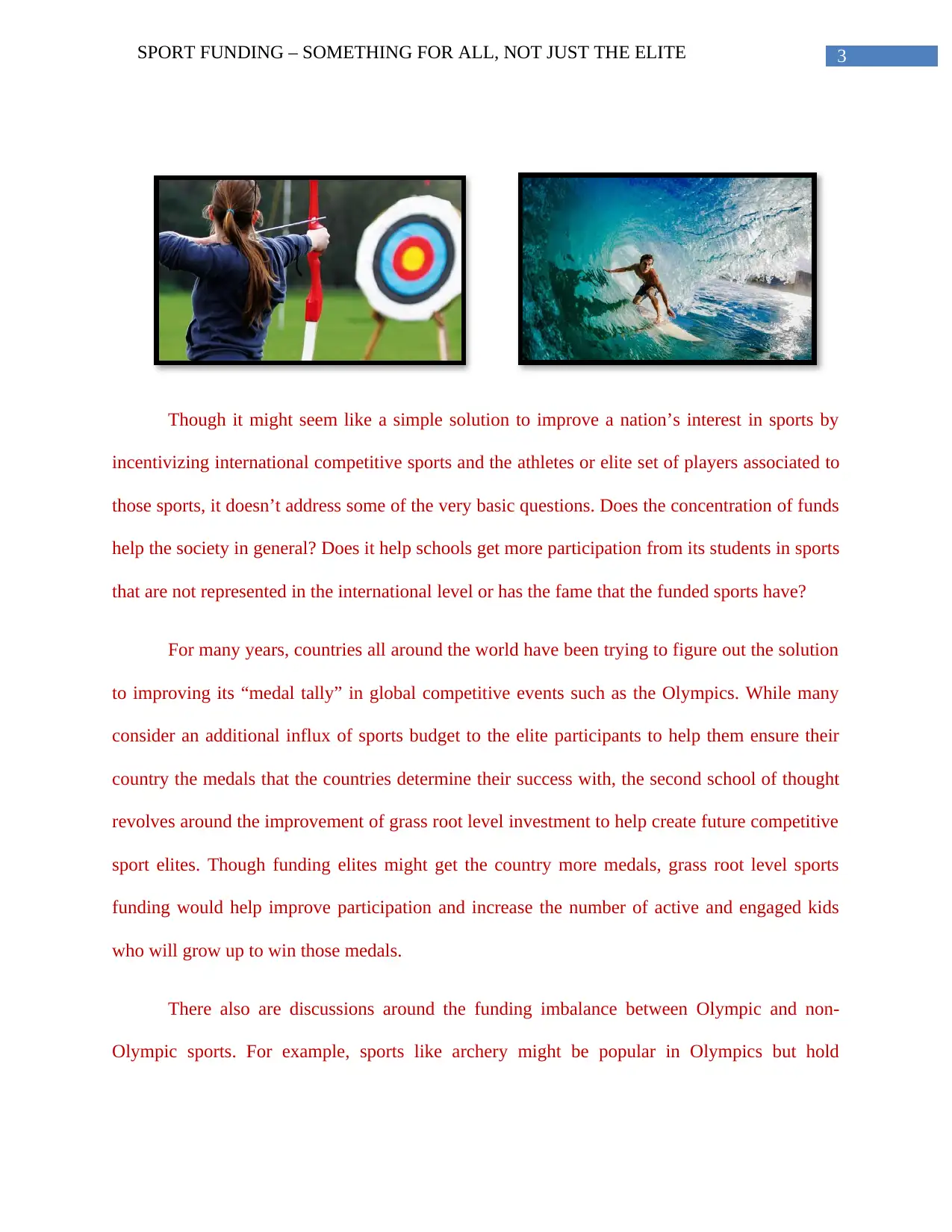
3SPORT FUNDING – SOMETHING FOR ALL, NOT JUST THE ELITE
Though it might seem like a simple solution to improve a nation’s interest in sports by
incentivizing international competitive sports and the athletes or elite set of players associated to
those sports, it doesn’t address some of the very basic questions. Does the concentration of funds
help the society in general? Does it help schools get more participation from its students in sports
that are not represented in the international level or has the fame that the funded sports have?
For many years, countries all around the world have been trying to figure out the solution
to improving its “medal tally” in global competitive events such as the Olympics. While many
consider an additional influx of sports budget to the elite participants to help them ensure their
country the medals that the countries determine their success with, the second school of thought
revolves around the improvement of grass root level investment to help create future competitive
sport elites. Though funding elites might get the country more medals, grass root level sports
funding would help improve participation and increase the number of active and engaged kids
who will grow up to win those medals.
There also are discussions around the funding imbalance between Olympic and non-
Olympic sports. For example, sports like archery might be popular in Olympics but hold
Though it might seem like a simple solution to improve a nation’s interest in sports by
incentivizing international competitive sports and the athletes or elite set of players associated to
those sports, it doesn’t address some of the very basic questions. Does the concentration of funds
help the society in general? Does it help schools get more participation from its students in sports
that are not represented in the international level or has the fame that the funded sports have?
For many years, countries all around the world have been trying to figure out the solution
to improving its “medal tally” in global competitive events such as the Olympics. While many
consider an additional influx of sports budget to the elite participants to help them ensure their
country the medals that the countries determine their success with, the second school of thought
revolves around the improvement of grass root level investment to help create future competitive
sport elites. Though funding elites might get the country more medals, grass root level sports
funding would help improve participation and increase the number of active and engaged kids
who will grow up to win those medals.
There also are discussions around the funding imbalance between Olympic and non-
Olympic sports. For example, sports like archery might be popular in Olympics but hold
Paraphrase This Document
Need a fresh take? Get an instant paraphrase of this document with our AI Paraphraser
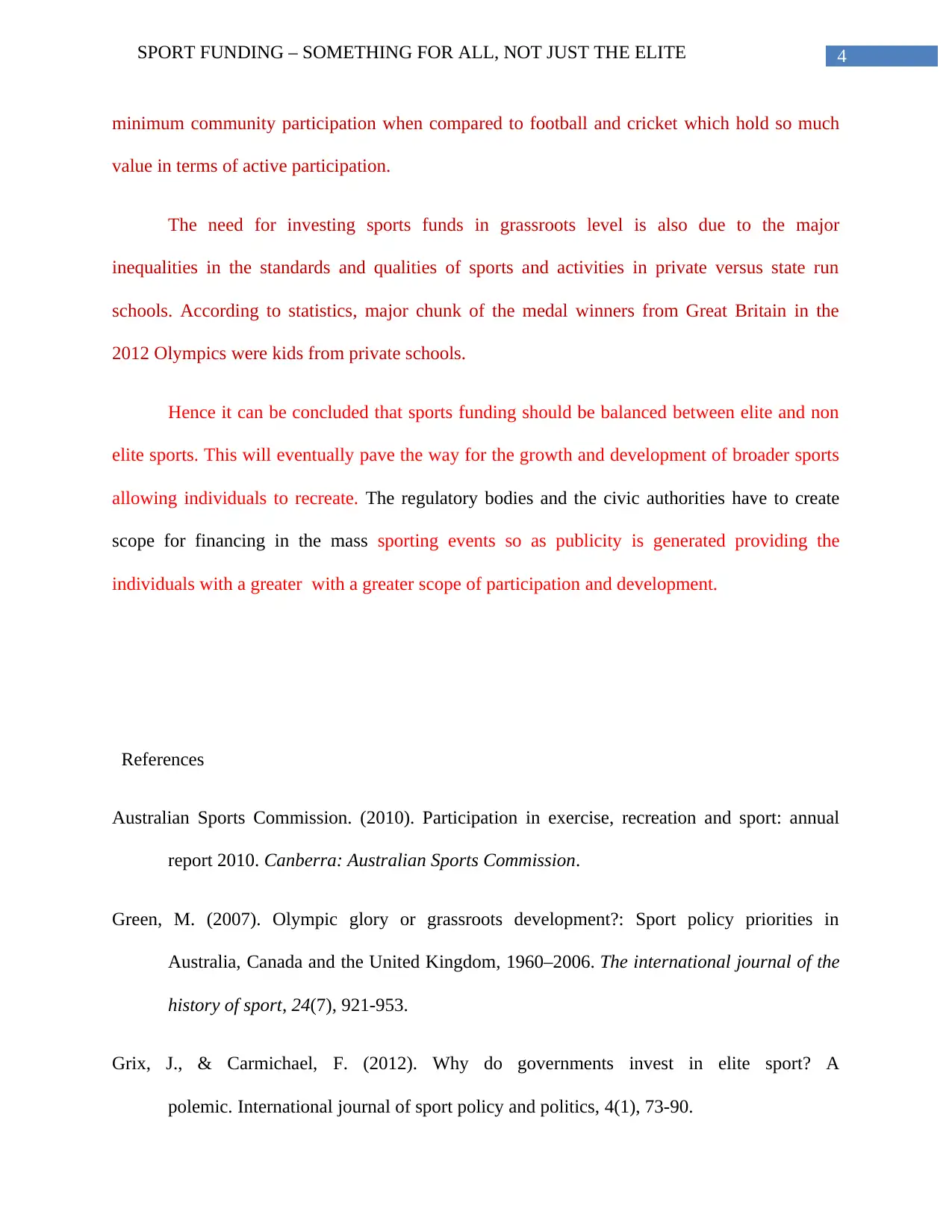
4SPORT FUNDING – SOMETHING FOR ALL, NOT JUST THE ELITE
minimum community participation when compared to football and cricket which hold so much
value in terms of active participation.
The need for investing sports funds in grassroots level is also due to the major
inequalities in the standards and qualities of sports and activities in private versus state run
schools. According to statistics, major chunk of the medal winners from Great Britain in the
2012 Olympics were kids from private schools.
Hence it can be concluded that sports funding should be balanced between elite and non
elite sports. This will eventually pave the way for the growth and development of broader sports
allowing individuals to recreate. The regulatory bodies and the civic authorities have to create
scope for financing in the mass sporting events so as publicity is generated providing the
individuals with a greater with a greater scope of participation and development.
References
Australian Sports Commission. (2010). Participation in exercise, recreation and sport: annual
report 2010. Canberra: Australian Sports Commission.
Green, M. (2007). Olympic glory or grassroots development?: Sport policy priorities in
Australia, Canada and the United Kingdom, 1960–2006. The international journal of the
history of sport, 24(7), 921-953.
Grix, J., & Carmichael, F. (2012). Why do governments invest in elite sport? A
polemic. International journal of sport policy and politics, 4(1), 73-90.
minimum community participation when compared to football and cricket which hold so much
value in terms of active participation.
The need for investing sports funds in grassroots level is also due to the major
inequalities in the standards and qualities of sports and activities in private versus state run
schools. According to statistics, major chunk of the medal winners from Great Britain in the
2012 Olympics were kids from private schools.
Hence it can be concluded that sports funding should be balanced between elite and non
elite sports. This will eventually pave the way for the growth and development of broader sports
allowing individuals to recreate. The regulatory bodies and the civic authorities have to create
scope for financing in the mass sporting events so as publicity is generated providing the
individuals with a greater with a greater scope of participation and development.
References
Australian Sports Commission. (2010). Participation in exercise, recreation and sport: annual
report 2010. Canberra: Australian Sports Commission.
Green, M. (2007). Olympic glory or grassroots development?: Sport policy priorities in
Australia, Canada and the United Kingdom, 1960–2006. The international journal of the
history of sport, 24(7), 921-953.
Grix, J., & Carmichael, F. (2012). Why do governments invest in elite sport? A
polemic. International journal of sport policy and politics, 4(1), 73-90.
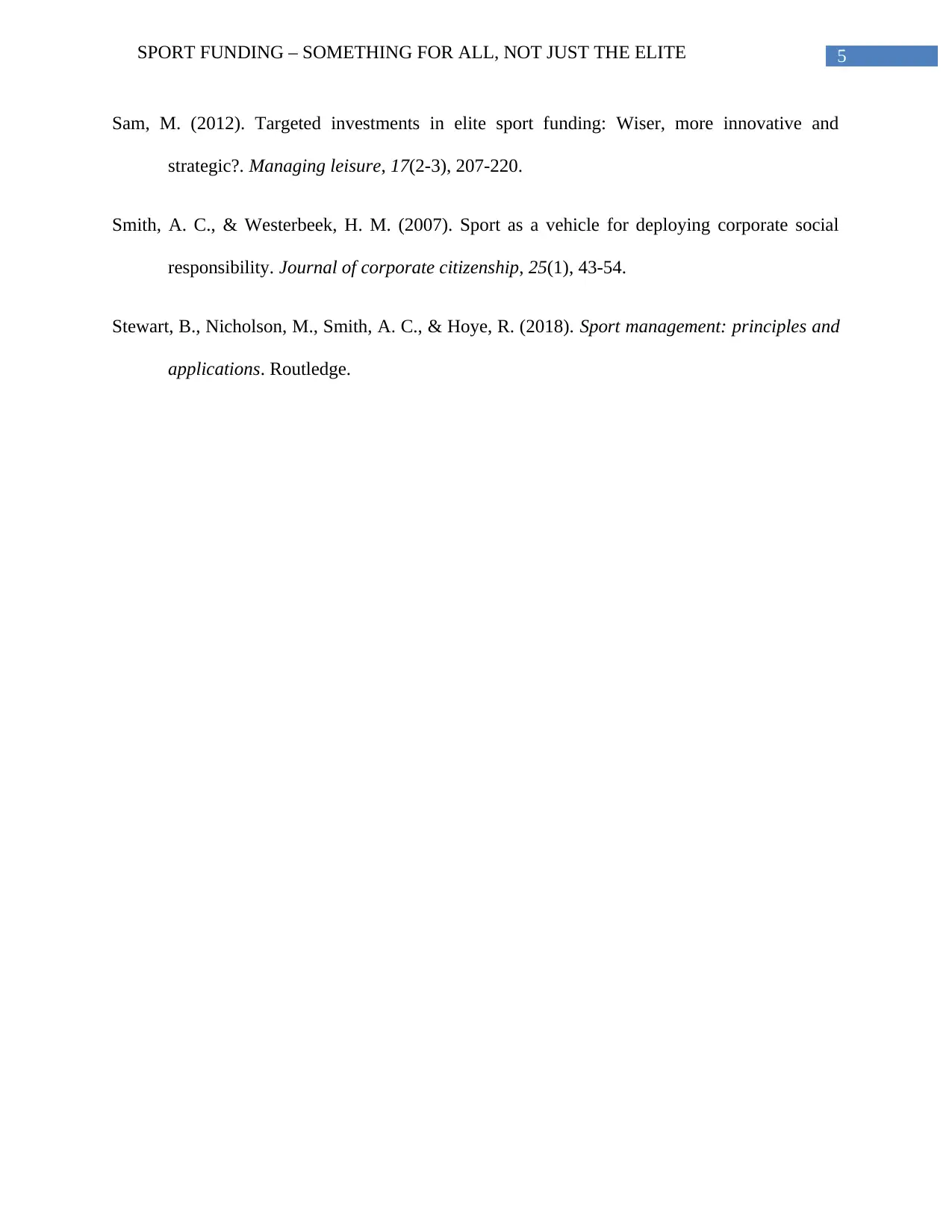
5SPORT FUNDING – SOMETHING FOR ALL, NOT JUST THE ELITE
Sam, M. (2012). Targeted investments in elite sport funding: Wiser, more innovative and
strategic?. Managing leisure, 17(2-3), 207-220.
Smith, A. C., & Westerbeek, H. M. (2007). Sport as a vehicle for deploying corporate social
responsibility. Journal of corporate citizenship, 25(1), 43-54.
Stewart, B., Nicholson, M., Smith, A. C., & Hoye, R. (2018). Sport management: principles and
applications. Routledge.
Sam, M. (2012). Targeted investments in elite sport funding: Wiser, more innovative and
strategic?. Managing leisure, 17(2-3), 207-220.
Smith, A. C., & Westerbeek, H. M. (2007). Sport as a vehicle for deploying corporate social
responsibility. Journal of corporate citizenship, 25(1), 43-54.
Stewart, B., Nicholson, M., Smith, A. C., & Hoye, R. (2018). Sport management: principles and
applications. Routledge.
⊘ This is a preview!⊘
Do you want full access?
Subscribe today to unlock all pages.

Trusted by 1+ million students worldwide
1 out of 6
Related Documents
Your All-in-One AI-Powered Toolkit for Academic Success.
+13062052269
info@desklib.com
Available 24*7 on WhatsApp / Email
![[object Object]](/_next/static/media/star-bottom.7253800d.svg)
Unlock your academic potential
Copyright © 2020–2025 A2Z Services. All Rights Reserved. Developed and managed by ZUCOL.




